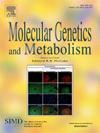星形胶质细胞A1表型的进行性激活是小胶质细胞-星形胶质细胞串扰的基础,并有助于神经性MPS的神经炎症
IF 3.5
2区 生物学
Q2 ENDOCRINOLOGY & METABOLISM
引用次数: 0
摘要
神经炎症是神经性粘多糖病(MPS)神经退行性过程的基础,已知先天免疫起主导作用。在这里,通过研究神经病变MPS小鼠模型,我们发现MPS小鼠的大脑中存在神经毒性反应性星形胶质细胞A1,并随着年龄的增长而逐渐增加。这种A1表型与激活的小胶质细胞和与A1表型相关的小胶质细胞介导的特定细胞因子子集的释放有关。此外,在MPS- iiia(人类最严重的神经性MPS之一)小鼠模型中,我们还发现神经炎症与转谷氨酰胺酶2的激活同时进行,转谷氨酰胺酶2是一种参与多种细胞过程的多功能酶,主要在小胶质细胞中。此外,淀粉样蛋白沉积似乎与这些过程的维持有关,事实上,抑制MPS-IIIA小鼠的淀粉样蛋白沉积可降低TG2表达、小胶质细胞激活和星形胶质细胞A1表型的相对数量。我们的研究结果揭示了神经性MPS的小胶质细胞-星形胶质细胞串扰及其在MPS的神经炎症和神经变性中的意义,从而也为这些疾病提供了新的治疗靶点。本文章由计算机程序翻译,如有差异,请以英文原文为准。
Progressive activation of the astrocyte A1 phenotype underlies microglia-astroglia crosstalk and contributes to neuroinflammation in neuronopathic MPS
Neuroinflammation underlies neurodegenerative processes in neuronopathic mucopolysaccharidoses (MPS), with innate immunity known to have a dominating role. Here, by studying mouse models of neuronopathic MPS, we found that the neurotoxic reactive astrocytes A1 are present in the brain of MPS mice and progressively increase with age. Such A1 phenotype is associated to activated microglia and to microglia-mediated release of a subset of specific cytokines involved in the A1 phenotype. Additionally, in the mouse model of MPS-IIIA, one of the most severe neuronopathic MPS in humans, we also found that neuroinflammation proceeded concomitantly with the activation of transglutaminase 2, a multifunctional enzyme involved in a variety of cellular processes, mostly in the microglia. Moreover, amyloid deposition appears to be associated to the maintenance of these processes, indeed, inhibiting amyloid deposition in MPS-IIIA mice reduced TG2 expression, microglia activation and the relative amount of astrocyte A1 phenotype. Our results shed light on the microglia-astroglia crosstalk in neuronopathic MPS and on its implication in neuroinflammation and neurodegeneration in MPS, thus also suggesting new therapeutic targets for these diseases.
求助全文
通过发布文献求助,成功后即可免费获取论文全文。
去求助
来源期刊

Molecular genetics and metabolism
生物-生化与分子生物学
CiteScore
5.90
自引率
7.90%
发文量
621
审稿时长
34 days
期刊介绍:
Molecular Genetics and Metabolism contributes to the understanding of the metabolic and molecular basis of disease. This peer reviewed journal publishes articles describing investigations that use the tools of biochemical genetics and molecular genetics for studies of normal and disease states in humans and animal models.
 求助内容:
求助内容: 应助结果提醒方式:
应助结果提醒方式:


